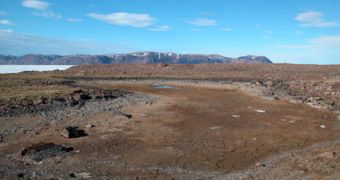You may think that Arctic is a continuous marsh, having thousands of small ponds.
"If you fly over, you see them everywhere," said John Smol of Queen's University in Kingston, Canada.
But a new research led by Smol has revealed that the Arctic ponds are now fast disappearing due to global warming. These ponds lie over the frozen soil (permafrost) or bedrock, freeze in the winter and then melt for just a few months each summer, turning into hot spots of life in the harsh Arctic terrain.
The ponds fill during summer with moss, algae, fairy shrimp, other tiny crustaceans and of course, the pain of the Arctic summer, the larvae of the mosquitoes and other blood sucking relatives. Still, the tiny animals represent the food for many birds (waterfowl, singing birds and waders), hunted by Arctic predators (foxes, falcons, owls). The ponds vary in size, being up to 3 ft (1 m) deep and around several hundred feet in diameter.
But now, some of these ponds are drying completely in the summer or shrinking to tiny puddles due to human caused global warming.
"The wetlands around some of the ponds are also disappearing, threatening the creatures that inhabit these areas. Now they're so dry you can put a match to it and they'll burn," said Smol.
Smol and Marianne Douglas at the University of Alberta in Edmonton have been monitoring for over two decades about 45 ponds on Canada's Ellsmere Island (off the northwest coast of Greenland).
Analyses of the sediments in these ponds focusing on the shells of diatoms, tiny algae that develop protective mineral sheaths around themselves, showed that the ponds had been relatively stable for several millenia until the 1800s, when the diatom species composition changed, a clear sign of warming clime.
In fact, recent warming increased the rainfall and snowfall amount in the area, compared to 20 years ago. But in the same time, higher summer temperature also raised evaporation, which overcomes the gain from the extra-water. Of the monitored ponds, 24 ponds were drying and shrinking and 3 dried completely in the summers of 2005 and 2006.
"We've seen, in our lifetime, in front of our eyes, some of these ponds dry up. It is quite striking. In wetter years the now-dry ponds may again fill with water. But they won't be the same again, since many of the organisms that once lived in the ponds have probably died," said Smol.
"The disappearance of lakes is occurring widely across the Canadian, Alaskan, and Siberian Arctic," said Larry Hinzman of the University of Alaska at Fairbanks.
Hinzman's team found in 2005 that in Siberia, just south of the Arctic Circle, lakes are disappearing! They believe that the permafrost beneath the lakes has been thawing, sucking the water like pulling the plug on a bathtub.
"These shrinking lakes will have a drastic ecological impact, which will reverberate through the northern life cycle. It will hurt migratory waterfowl and the people who depend on the lakes for subsistence hunting and fishing. This will certainly continue, and probably accelerate for the foreseeable future." explained Hinzman.

 14 DAY TRIAL //
14 DAY TRIAL //